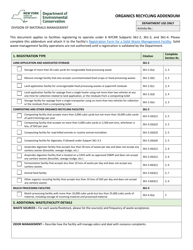Organics Recycling Addendum - New York
Organics Recycling Addendum is a legal document that was released by the New York State Department of Environmental Conservation - a government authority operating within New York.
FAQ
Q: What is the Organics Recycling Addendum?
A: The Organics Recycling Addendum is a program in New York that aims to promote recycling of organic waste.
Q: What is organic waste?
A: Organic waste refers to biodegradable materials such as food scraps, yard waste, and other plant and animal-based materials.
Q: Why is it important to recycle organic waste?
A: Recycling organic waste helps reduce the amount of waste sent to landfills, reduces greenhouse gas emissions, and creates nutrient-rich compost.
Q: How can I participate in the Organics Recycling Addendum?
A: Residents can participate by separating their organic waste from regular trash and disposing of it in designated organics recycling bins or participating in composting programs.
Q: What happens to the organic waste after it is collected?
A: The collected organic waste is typically sent to a composting facility, where it is processed into nutrient-rich compost that can be used for gardening and landscaping.
Q: Are there any costs or fees associated with participating in the program?
A: Program costs vary depending on the municipality, but in many cases, there may be no additional costs or fees for residents to participate in the program.
Q: What are the benefits of recycling organic waste?
A: Recycling organic waste helps conserve landfill space, reduce greenhouse gas emissions, protect the environment, and support sustainable practices.
Q: Can I compost organic waste at home?
A: Yes, many residents can compost their organic waste at home using compost bins or backyard composting methods.
Q: What materials can be composted?
A: Common compostable materials include fruit and vegetable scraps, coffee grounds, yard trimmings, grass clippings, leaves, and plant-based paper products.
Q: Can meat and dairy products be composted?
A: Some composting programs accept meat and dairy products, but it is best to check with your local program for specific guidelines.
Form Details:
- The latest edition currently provided by the New York State Department of Environmental Conservation;
- Ready to use and print;
- Easy to customize;
- Compatible with most PDF-viewing applications;
- Fill out the form in our online filing application.
Download a fillable version of the form by clicking the link below or browse more documents and templates provided by the New York State Department of Environmental Conservation.






